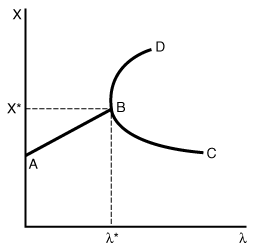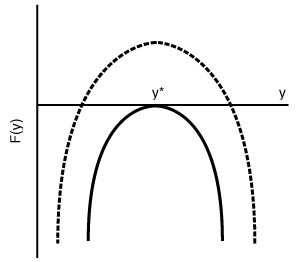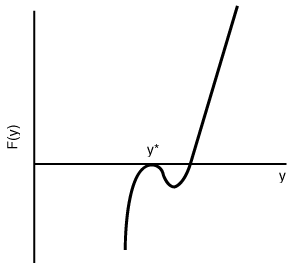Chapter 12: Steady-State Nonisothermal Reactor Design: Flow Reactors with Heat Exchange
R12.2 Steady-State Bifurcation Analysis
All equation numbers refer to 4th edition of Elements of CRE
| In reactor dynamics it is particularly important to find out if multiple stationary points exist or if sustained oscillations can arise. Bifurcation analysis is aimed at locating the set of parameter values for which multiple steady states will occur.1 We apply bifurcation analysis to learn whether or not multiple steady states are possible. A bifurcation point is a point at which two branches of a curve coalesce as a parameter is varied. Consider the function |
|||
|
|
(DVD12-1) | ||
| is satisfied. We see that as we start to increase TIME GIF along AB, there is only one value of x for a given There is another condition that is necessary for a bifurcation point to exist. If we were to move an incremental amount |
|||
|
|
(DVD12-2) | ||
 Figure DVD12-1 |
|||
| Expanding Equation (DVD12-2) in a Taylor series, it can be shown that at the bifurcation point | |||
|
|
(DVD12-3) | ||
| If Equations (DVD12-1) and (DVD12-3) are satisfied, there will be a set of parameter values for which we will have multiple steady states (MSS). We shall continue the discussion of the first-order reaction taking place in a CSTR to illustrate bifurcation analysis. A slight rearrangement of a combination of Equations (8-68) and (8-69) from the energy balance gives |
|||
|
|
(DVD12-4) | ||
| which is of the form | |||
|
|
(DVD12-5) | ||
| where |
|||
| Similarly, with some minor manipulation, the mole balance on an isothermal CSTR can be put in similar forms, | |||
|
|
(DVD12-6) | ||
| or | |||
|
|
(DVD12-7) |
||
| We observe that both the CSTR energy and mole balances are of the form | |||
|
|
|
(DVD12-8) | |
| If F(y) is a monotonically increasing function as shown in Figure DVD12-2, the derivative of the function with respect to y will never be zero, that is, | |||
|
|
|||
| Upon differentiating Equation (DVD12-8), we have | (DVD12-9) | ||
|
|
|||
| and we see that dF/dy can never be zero if the maximum value of the derivative of G is less than |
|||
|
Uniqueness
|

|
(DVD12-10) | |
When Equation (DVD12-10) is satisfied there will be no multiple steady states. However, if max  Figure DVD12-2  Figure DVD12-3 |
|||
|
Conditions for
multiple steady states |

|
(DVD12-11) (DVD12-12) |
|
| Figure DVD12-2 shows that a parabola satisfies both conditions (1) and (2), that is, Equations (DVD12-11) and (DVD12-12), respectively. Consequently, we see that there will be a set of parameter values for which multiple solutions will exist, as demonstrated by the dashed-line parabola. Figure DVD12-3 shows the shape of a typical curve in reaction systems with multiple steady states. |